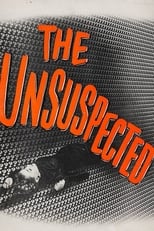John Chard
Apr 20, 2020
7/10
Sounded too much like the truth to be true!
The Unsuspected is directed by Michael Curtiz and adapted to screenplay by Bess Meredyth and Ranald MacDougall from the novel written by Charlotte Armstrong. It stars Joan Caulfield, Claude Rains, Audrey Totter, Constance Bennett, Hurd Hatfield and Ted North. Music is by Franz Waxman and cinematography by Elwood Bredell.
A girl has been murdered but the police think it's suicide. A woman presumed killed at sea returns to the family home and finds she has a husband she can't remember. Her uncle hosts a radio murder mystery show where the stories seem spine chillingly real. And of course there's finances to be lost or gained. Just what is going on at the Grandison Mansion?
If you don't get a hold of yourself your mind will crack!
Not as obscure as it once was, The Unsuspected has emerged as a film noir favourite in spite of its self-conscious style over substance being. With similarities to Otto Preminger's Laura, amongst others, and weakness of plot machinations, you sense that the great Michael Curtiz realised he had to up the ante in the art of expressionistic chiaroscuro to off-set the short fall elsewhere in the production. But boy does he!
Aided by Bredell (Phantom Lady/The Killers), Curtiz (Casablanca/Mildred Pierce) produces a masterclass in imaginative direction. Lighting and shadows are used to full effect in portraying the psychological discord that beats constantly in the lavish mansion where majority of the tale is set, a place where paranoia, confusion and claustrophobia finds a home. Silhouettes of crimes committed strike atmospheric chords, as do the uses of bar shadows.
As the script merrily trundles out sexually suggestive and witty barbs, the array of characters portrayed with relish by a Curtiz inspired cast, the director also inserts some stunning scenes. A neon sign deftly shot, billowing curtains suggesting turmoil, a bubbling glass of tainted champagne a foreboding presence, and many off-kilter reflections used throughout to represent duplicity or a fractured mind. Visually this is noir nirvana for sure.
If only the screenplay was as intricate as it thinks it is, where quite often the story gets saddled with giant implausibilities. As the bodies pile up the motives and means start to come off as daft, which is a shame as the radio inspired backdrop is interesting for the time. There's also a couple of well constructed action scenes, though the editing for the cars is suspect, while Hatfield raises a laugh (intentional?) when in one scene he reminds us he was Dorian Gray two years earlier.
A must see on a visual basis for the film noir enthusiast, but the core basic melodramatics of the tale may have you hankering for Laura after all. 7.5/10
